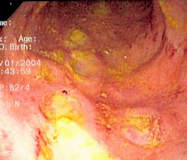
Crohn’s disease is a chronic inflammatory bowel disease of the gastrointestinal mucosa that can affect any portion of the gastrointestinal tract, from mouth to anus. A disorder that occurs in genetically susceptible people, it is mediated by T lymphocytes as a result of a breakdown in the regulatory restraint on mucosal immune responses to enteric bacteria. It is a life-long disease often characterised by chronic diarrhoea, abdominal pain, anorexia, fever and musculoskeletal abnormalities, and is usually complicated by fistulae.
Crohn’s disease affects males and females equally, and occurs typically between the ages of 15 and 35 years. The most commonly affected areas are the terminal ileum (35%), the ileocaecal region (40%) and the colon (20%), while the rectum is rarely affected. Patients frequently have flares with varying degrees of remission.
Perianal complications can occur at any time during the course of the disease and is usually observed in approximately 49-62% of paediatric Crohn’s disease patients. Some children remain asymptomatic, but in others it is a cause of major disability. Skin tags or haemorrhoids, fissures, ulcers, strictures, stenoses, abscesses, fistulas and neoplasia are commonly occurring perianal complications.
Treatment for Crohn’s disease
There are several ways to classify Crohn’s disease, but there is no gold standard to assess its severity and diagnosis. Generally, diagnosis is undertaken by detailed questioning and tests, clinical evaluation and the omission of other diseases.
Severity can be assessed by the Crohn’s Disease Activity Index. This index is based on stool number, abdominal pain, general wellbeing, extraintestinal symptoms, use of antidiarrhoeal drugs, the presence of abnormal mass and haematocrit, and body weight.
The management of Crohn’s disease is based on the site, extent and disease activity, and the presence of complications. The therapeutics goals are to induce and maintain remission to improve the overall quality of life. There are two ways to manage Crohn’s disease: pharmacological and surgical. Aminosalicylates, corticosteroids, antibiotics, immunosuppressants and biologics such as Remicade (infliximab), Humira (adalimumab), Cimzia (certolizumab pegol) and Tysabri (natalizumab) are used to treat Crohn’s disease, but it can also be managed by changing diet habits.
The surgical management of Crohn’s disease is reserved for those patients who do not respond to medical therapy. Approximately 75-85% of patients require at least one surgical operation over the course of the disease. The most common indications for surgery are:
¦ localised disease segment causing severe symptoms not responding to drug therapy
¦ abdominal abscess not controlled by antibiotics or percutaneous drainage
¦ strictures causing obstructive symptoms
¦ perianal sepsis requiring drainage.
Crohn’s disease therapeutics market
The global Crohn’s disease therapeutics market grew at a compound annual growth rate (CAGR) of 25.2% from $1.2bn in 2005 to $3.6bn in 2010. This high rate of growth is primarily attributed to the launch of biologics such as Humira, Cimzia and Tysabri, and the increased uptake of the biologics Remicade and Entocort EC (budesonide). The market is forecast to show moderate growth, at a CAGR of 2.6% for the next eight years, to reach $4.4bn by 2018. This reduced growth will come as a result of the patent expiries of Remicade and Entocort EC and the subsequent launch of biosimilars.
Although research efforts have been made to explore the etiology and pathophysiology of Crohn’s disease, there exists no pharmacologic agent that can induce remission and completely cure the disease. Existing anti-TNF agents have shown promising activity against fistulising and active Crohn’s disease, but are only able to provide symptomatic relief and lack any curative properties. Hence, there are several unmet needs and clinical challenges that need to be addressed. Most of these unmet needs are related to efficacy and safety issues such as immunogenicity, loss of response and adverse effects, and imply that the market is only moderately served by the current product options, and that there is significant scope for new entrants to capture value from underserved segments.
The annual cost of therapy for branded products is $3,300-$16,848. A new product with superior results over existing ones may be sold at a higher price, while for new products that retain the same efficacy and safety, pricing would be one potential leverage point.
There are dozens of molecules in various phases of clinical development. The four in Phase III development – Prochymal, Stelara, Traficet-EN and Vedolizumab – are more efficacious and safer than existing products, and are likely to provide more options for physicians. Phase III and Phase II/III consist of five molecules, Phase II and Phase I/II consist of 19 molecules, Phase I has seven, and discovery and preclinical together consist of 15 molecules. Overall, the figures suggests that the pipeline for the Crohn’s disease therapeutics market is strong and there exists an opportunity for the novel pipeline molecules in the late stage of clinical development to capture the underserved market.
The key players in the future include GlaxoSmithKline, Osiris, Takeda Pharmaceuticals, Novartis, Novo Nordisk, Teva Pharmaceutical Industries and Amgen. Competition is also strong in the current market. Johnson & Johnson’s Remicade is the market leader, followed by AstraZeneca/Promethus’s Entocort EC, Biogen Idec’s Tysabri, UCB’s Cimzia and Abbott’s Humira. As no drug offers a cure for the disease, the induction and maintenance of clinical remission remains the key efficacy parameter. With all the biologics offering a similar efficacy and safety profile, the three decisive factors that could be used to differentiate them could be pricing, patient and physician satisfaction.
Crohn’s disease and the role of biologics
The prescription and uptake of new biologics will depend on the advantages they offer over existing therapies. Generally, a gradual increase is being seen in the uptake of biologics, and these emerging therapies along with the existing biologics will continue to drive market growth. The market is expected to witness intensifying competition, and a price war among the biologics will ensue in the future.



